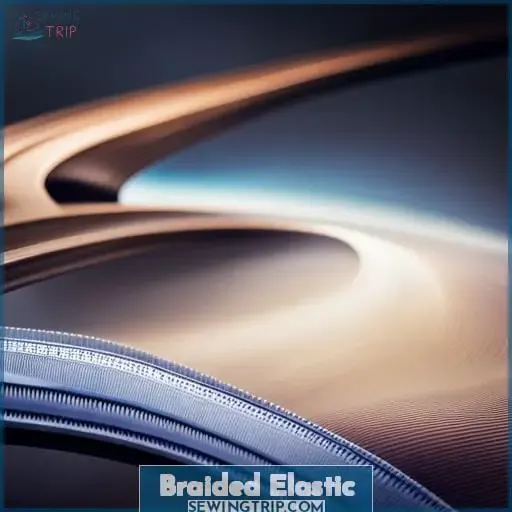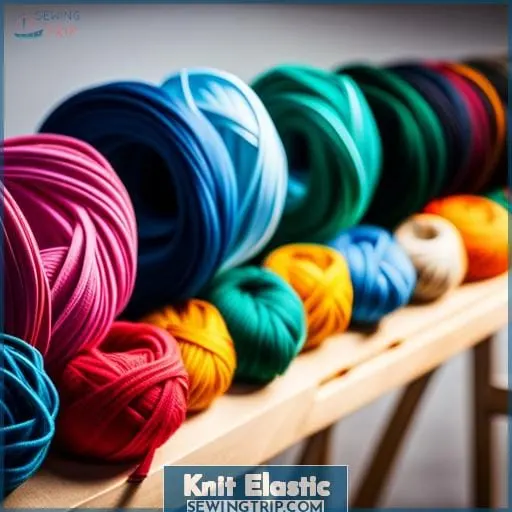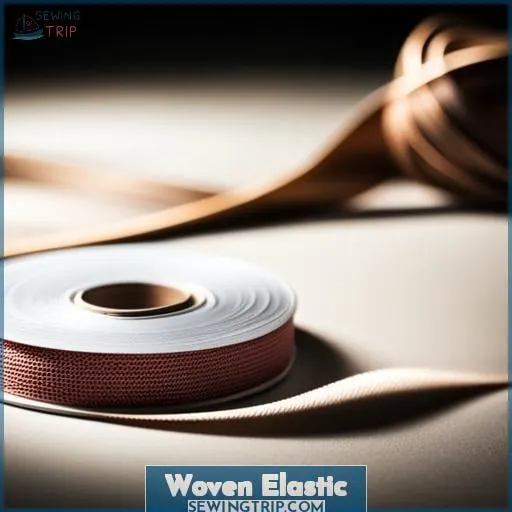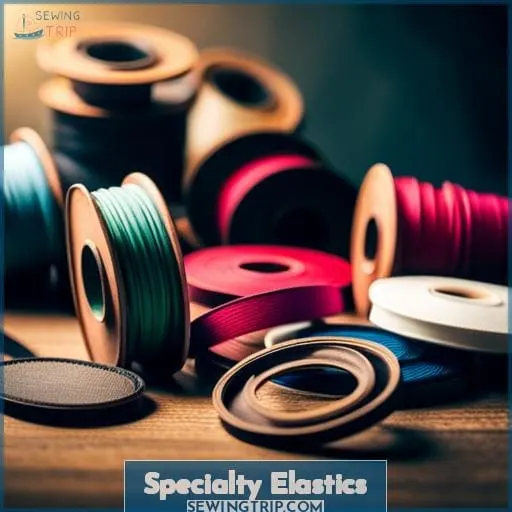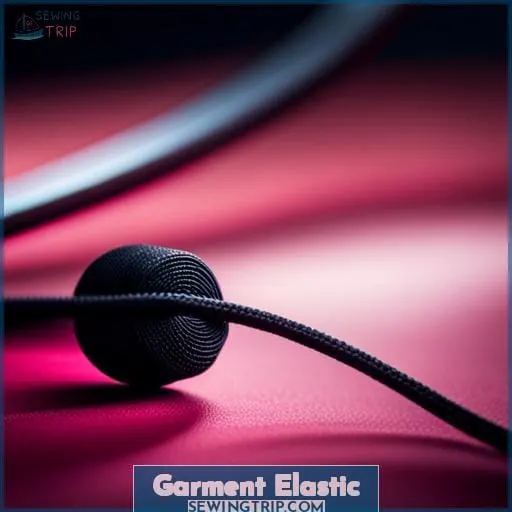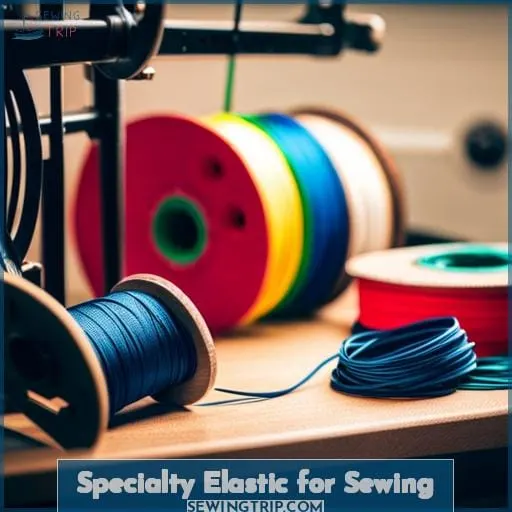This site is supported by our readers. We may earn a commission, at no cost to you, if you purchase through links.
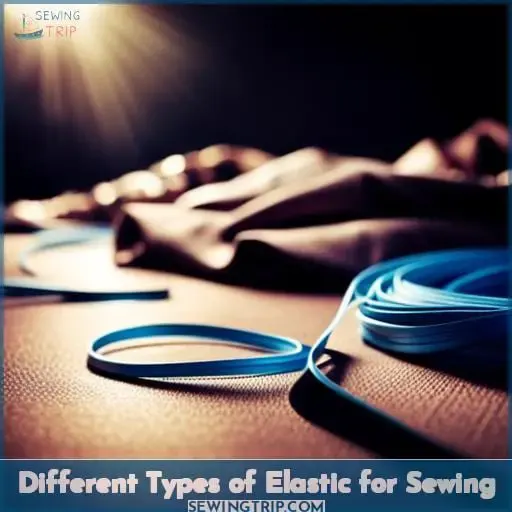 Picture yourself standing in front of a vibrant wall filled with different types of elastic. It may seem overwhelming at first, but fear not! In this article, we’ll guide you through the world of sewing elastics and help you choose the perfect one for your project.
Picture yourself standing in front of a vibrant wall filled with different types of elastic. It may seem overwhelming at first, but fear not! In this article, we’ll guide you through the world of sewing elastics and help you choose the perfect one for your project.
From braided to woven to knitted elastics, each type has its own unique properties that can make all the difference in your sewing endeavors.
Table Of Contents
Braided Elastic
When sewing, consider using braided elastic for applications where you need a lot of stretch.
Braided elastic is easily recognizable by its horizontal ribs and has the unique characteristic of narrowing when stretched. This type of elastic isn’t suitable for sewing through directly but works best when used in a casing.
With its excellent stretchiness, braided elastic is ideal for waistbands, hems, and any other project that requires significant flexibility.
One important factor to keep in mind when selecting braided elastic is its width. Elastic comes in various widths ranging from 1/4 inch to 3 inches or more. Thinner elastics are typically used for swimwear and necklines while wider ones are commonly employed on waistbands for skirts and pants.
In terms of durability, woven elastics tend to be the strongest due to their thick vertical and horizontal strips; however, braided elastics still offer good longevity if properly cared for during use.
Overall sewability depends on the specific application requirements as well as personal preference regarding ease of handling during stitching.
To summarize, the choice between different types of elastics ultimately boils down to your specific needs—braided being most appropriate where ample stretchiness is required such as with waistbands and hems.
Knit Elastic
To use knit elastic, you simply sew it onto your garment using a straight stitch.
Knit elastic is a stretchy and comfortable option for sewing projects that require flexibility and ease of movement. Unlike braided elastic, which can be grippy and narrow when stretched, knit elastic retains its width even when under tension.
Knit elastic is made by knitting fibers together, resulting in a soft and durable material that’s perfect for items touching the skin or areas where comfort is essential.
There are different variations of knit elastics available depending on your specific needs.
- Clear elastic can be used to stabilize seams or gather knits while remaining virtually invisible due to its transparency.
- Fold-over elastic offers versatility as it can be folded over raw edges for finishing touches on garments such as underwear or headbands.
- For those working with swimwear or lingerie projects, there are specialized options like swim elastic and lingerie elastic.
Woven Elastic
If you want a strong and durable elastic that can be sewn through, woven elastic is the perfect choice for your sewing projects.
Woven elastic is recognizable by its thick vertical and horizontal strips. It provides a firm hold and retains its shape without rolling or twisting when stretched. This makes it ideal for use in applications where stability is key, such as waistbands or casings on medium to heavyweight fabrics.
Woven elastic can easily be sewn onto your garments, giving them added strength and support. Its non-roll properties ensure that it stays in place even during extended wear or movement.
When choosing woven elastic, consider the fiber content of the fabric you’re working with to ensure compatibility.
Elastic widths vary depending on the project requirements. Thinner widths are suitable for swimwear or delicate necklines while wider options work well as waistbands for skirts and pants.
Incorporating different types of elastics into your sewing repertoire allows you to tailor each garment’s functionality according to specific needs.
Woven Elastic adds firmness, support, and durability ensuring liberation, power, and mastery over all future sewing projects!
Specialty Elastics
Now let’s talk about some specialty elastics that are used for specific purposes in sewing.
- Swim elastic, made with cotton, is designed to resist chlorine, saltwater, and sunscreen.
- Stretch lace elastic is soft and flexible, conforming to the body and commonly used for underwear and lingerie.
- Clear elastic is thin and transparent but can stretch up to 3-4 times its original length – it’s great for stabilizing seams in neckbands or waistbands.
- Lastly, fold over elastic (FOE) has a seam running down the middle which allows it to be used like bias binding – perfect for items touching the skin.
Swim Elastic
For sewing swimwear, consider using swim elastic for added durability and resistance to chlorine, saltwater, and sunscreen.
It comes in various widths and stretches well.
Look for reputable brands that offer the right size for your project.
Sewing swim elastic is easy with a zigzag stitch or by creating buttonholes on waistbands.
Stretch Lace Elastic
When using stretch lace elastic for sewing, you’ll love how it adds a soft and flexible touch to your garments. It’s comfortable against the skin and perfect for creating delicate lingerie pieces that provide both comfort and style.
- Soft: Stretch lace elastic is made from soft materials that feel gentle against the skin.
- Comfortable: This type of elastic ensures maximum comfort when worn, making it ideal for underwear or delicate clothing items.
- Flexible: The stretchiness of this elastic allows it to conform easily to different body shapes, providing a snug fit without sacrificing comfort.
With stretch lace elastic, you can create beautiful garments that aren’t only fashionable but also incredibly comfortable to wear.
Clear Elastic
Now let’s explore the benefits of using clear elastic, a specialty elastic commonly used in sewing projects.
Clear elastic is perfect for:
- Stabilizing and gathering knits
- Helping areas of garments stay in place on the body
It can be easily sewn on and provides excellent stretchability.
Fold Over Elastic
To continue our exploration of specialty elastics, let’s dive into the world of fold over elastic (FOE).
FOE is a flat elastic with a seam running down the middle. It can be used like bias binding for sewing and hemming projects. Its width and stretchiness make it perfect for finishing edges on garments or accessories.
Garment Elastic
Choose the appropriate garment elastic based on your specific sewing needs and preferences.
When it comes to sewing garments, you want to ensure that the elastic you choose provides the right amount of stretch, matches the fabric material and color, and is easy to sew with.
For waistbands or hems that require a lot of stretch, braided elastic is an excellent choice. Its lengthwise ridges provide a secure grip while stretching but may not be suitable for sewing through directly due to its texture.
Knit elastic, on the other hand, offers a softer feel and retains its width when stretched—perfect for comfortable garments that need a smooth finish.
If you’re working with medium-weight or heavyweight fabrics in sew-on applications or casings, woven elastic would be ideal because it’s firm yet flexible enough.
In addition to these basic types of garment elastics are special ones designed for specific purposes such as swimwear or lingerie construction.
Specialty Elastic for Sewing
Let’s talk about some specialty elastic options for your sewing projects.
Fold-over elastic, also known as FOE, is a flat elastic with a seam running down the middle that can be used like bias binding and is great for items touching the skin.
Lace lingerie elastic, on the other hand, is soft and flexible and mostly used in underwear and lingerie to provide comfort and conform to the body.
These specialty elastics offer unique features that can enhance your garments in different ways.
Fold-Over Elastic for Sewing
Fold-over elastic is a versatile and convenient specialty elastic for sewing. It can be used in various ways to add both functionality and style to your projects.
- One popular use of fold-over elastic is for waistbands, providing a comfortable and adjustable fit.
- You can also use it to create hair ties that are gentle on the hair while still holding securely in place.
- Additionally, fold-over elastic works great for finishing necklines, adding a clean and professional look.
- Don’t forget about using this type of elastic for skirts too!
With some practice, you’ll master how to sew fold over elastic effortlessly into your garments.
Lingerie Elastic for Sewing
As we continue our exploration of elastic types for sewing, let’s delve into the specialty elastic known as lingerie elastic.
Lingerie elastic is a soft and flexible type of elastic that’s specifically designed for use in underwear and lingerie. It conforms to the body comfortably, providing support and flexibility where needed.
When sewing with lingerie elastic, it’s important to use a stretch stitch or zigzag stitch to ensure durability.
You can find different types of lingerie elastics at fabric stores or online retailers like Sewing Elastic Co.
Popular brands include Dritz, Bra-Makers Supply, and Wawak Sewing Supplies.
Conclusion
So, there you have it – a comprehensive guide to the different types of elastic for sewing!
Whether you’re a beginner or a seasoned pro, understanding the unique properties of braided, woven, and knitted elastics can greatly enhance your sewing projects.
So next time you’re faced with that vibrant wall of elastics, remember to consider the specific needs of your project and choose the perfect elastic to bring it to life.
Happy sewing!

